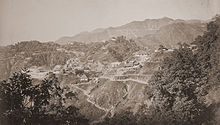Mussoorie is a hill station and a municipal board in the
Dehradun District of the northern Indian state of
Uttarakhand. It is located about 35 km from the state capital
of Dehradun and 290 km north from the national capital of
New Delhi.
Tourism is the most significant segment of Mussoorie's economy. It has a nature walk known as "Camel's Back Road". This road takes its name from a rocky outcrop in the shape of a camel's hump. Along the road, a cemetery is located about mid-way on the loop. There is also "Gun Hill" where a cannon was used to sound out midday for many years. Gun Hill is accessible by the cable car on the Mall road. The oldest Christian church in the Himalayas, St Mary's, is situated above Mall Road, and is currently undergoing restoration. Kempty Falls is a nice picnic spot. Company Garden is popular tourist destination. During season, the Company Garden has a vast collection of flowers and plants. Happy Vally has a small Tibetan temple. This was the first Tibetan temple built in India. The temple was constructed in 1960 by the Tibetan refugees. Lal Tibba is another tourist spot of Mussoorie. PicturesqueDhnaulti hill station is about 32 kilometres from Mussoorie. Mussoorie also had India's largest roller skating rink.
Nahata Estate Previously known as "Childer's Lodge" is a huge property of more than 300 acres, owned by the Harakh chand nahata family. It is the highest peak of Mussoorie near Lal Tibba, it is situated at 5 km from the Tourist Office and one can go on horse back or on foot. The view of snow-clad mountains is exhilarating.
GunHill Second highest point of Mussoorie, at an altitude of 2024m located at
30.4953°N 78.0745°E
Kempty Fall The Kempty Falls are situated on the hilly tracks of Uttarakhand, India, 15 km from Mussoorie on the Chakrata Road. This place is located nearly 1364 meters above sea level at 78°-02’East longitude and 30° -29’North latitude.
Lake Mist About 5 km before Kempty Falls on the Mussoorie-Kempty road is a good picnic spot with accommodation and restaurant facilities; boating is also available. With the Kempty river flowing through it, Lake Mist has many small waterfalls made by the river.
Municipal Garden Is a picnic spot having a garden and an artificial mini lake with paddle boating facility. It is located at a distance of 4 km by rickshaw cycles, pony or by a car and 2 km via Waverly Convent School road on foot.
Mussoorie Lake A newly developed picnic spot build by City Board & Mussoorie Dehradun Development Authority, is situated at 6 km on Mussoorie-Dehradun road having a facility of pedaled boats. It offers a view of Doon Valley and nearby villages.

A honeymooning couple find some romantic moments on top of Gunhill, Mussourie
Bhatta Falls 7 km from Mussoorie on Mussoorie-Dehradun Road near Bhatta Village. Accessible by car or bus up to Bhatta from where the fall is 3 km by foot. A fall with different ponds for bathing and water amusements, an ideal place for a picnic.
Jharipani Fall Located at 8.5 km from Mussoorie on Mussoorie-Jharipani road. One can go by local bus or car up to Jharipani from where the fall is about 1.5 km on foot.
Mossy Fall The fall is surrounded by a dense forest and is 7 km from Mussoorie. One can go there via Barlowganj or Balahisar.
Sir George Everest's House Park Estate is where one can find the remains of the building and laboratory of Sir George Everest, the Surveyor generel of India from 1830 to 1843. It is after George Everest that the world's highest peak Mt. Everest is named.
[4] It is 6 km from Gandhi Chowk / Library Bazaar and is accessible by vehicle, although the road is very rough beyond Haathi Paon. The place provides a view of Doon Valley on one side and a panoramic view of the Aglar River valley and the snow peaks of the Himalayan ranges on the other. It is a scenic walk from Library Bazaar, and a picnic spot.
Nag Devta Temple An ancient temple dedicated to Snake God Lord Shiva and is situated on Cart Mackenzie Road about 6 km from Mussoorie on the way to Dehradun. Vehicles can go right up to the temple. This place provides an enchanting view of Mussoorie and the Doon Valley.

Mussoorie and Landaur, 1860s
Jwalaji Temple (Benog Hill) Situated at an altitude of 2240 m, this temple is 9 km west of Mussoorie. It is situated on the top of Benog Tibba (Hill) and contains an old idol of Goddess Durga. There is a view of the Aglar River valley. It cannot be accessed by vehicle although a motor road goes most of the way from Mussoorie.
Cloud End This hotel is surrounded by thick deodar forest. The bungalow, built in 1838 by a British major, was one of the first four buildings of Mussoorie and has now been converted into a hotel. The place provides peace and calm and is full of flora and fauna.
Van Chetna Kendra 11 km to the South of library point lies an old sanctuary established in 1993 and covering an area of 339 hectares. It is famous for the extinct bird species Mountain Quail (Pahari Bater), which was last spotted in 1876.
Mussoorie is a popular destination for honeymooning couples, mainly because of its relatively cool climes and calm and lovely environment.









































